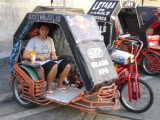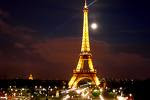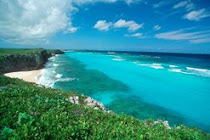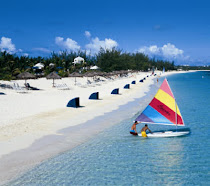by Mylene Ruby Llander
Have you ever visited this website: http://www.new7wonders.com/...? Have you tried voting our nominees for the new Seven Wonders of the World? Well, if your answer is NO, I’m here to proudly introduce the 4 nominees of the Philippines: The Tubbataha Reef which can be found in Sulu Sea, The Mayon Volcano that can be seen in Bicol, The Chocolate Hills which can be seen in Bohol and last but not the least, The Subterranean River National Park which is located in Palawan. These are the 4 nominees of the Philippines for the next Seven Wonders of the World. Tubbataha is nominated for the New Seven Wonders of Nature, and I wanted to nudge its nominations a little.
 The Tubbataha Reef is an island of coral that encircles a lagoon partially or completely located in the Sulu Sea of the Philippines. The word tubbataha is a combination of two Samal words which means "a long reef exposed at low tide". This remote set of islands is designated by the UNESCO as one of the World Heritage Sites. The reefs are reached by motor boat from Puerto Princesa City in Palawan and are one of the popular diving sites within the area. Last year, the Tubbataha Reef figured in the news when the activist group Greenpeace, while documenting the effects of global warming on the world’s reefs aboard their ship Rainbow Warrior, damaged a wide swath of the reef. The organization paid a 384,000-peso fine while blaming the government for providing inaccurate navigational maps.
The Tubbataha Reef is an island of coral that encircles a lagoon partially or completely located in the Sulu Sea of the Philippines. The word tubbataha is a combination of two Samal words which means "a long reef exposed at low tide". This remote set of islands is designated by the UNESCO as one of the World Heritage Sites. The reefs are reached by motor boat from Puerto Princesa City in Palawan and are one of the popular diving sites within the area. Last year, the Tubbataha Reef figured in the news when the activist group Greenpeace, while documenting the effects of global warming on the world’s reefs aboard their ship Rainbow Warrior, damaged a wide swath of the reef. The organization paid a 384,000-peso fine while blaming the government for providing inaccurate navigational maps.
There are over a thousand species of marine life which can be found in the reef and man y of them are already endangered. Among its amazing marine animals are pawikan or tortoise, manta and eagle rays, clownfish, white and black tip reef sharks, barracudas and schools of jacks and snappers.
y of them are already endangered. Among its amazing marine animals are pawikan or tortoise, manta and eagle rays, clownfish, white and black tip reef sharks, barracudas and schools of jacks and snappers.
With its marvelous and diverse ecosystem, it has become a popular and favorite spot for divers and the number of people who want to explore its beauty has been increasing every year. In fact, dedicated ships that operate during the “Tubbataha Season” are booked years in advance.
Being on the 7 wonders list is great! More and more the Philippines are being recognized for the beauty that it has kept hidden. Personally, I think tourism is the way to go for us. But because Tubbataha is so isolated, and the live-aboards are few, that area will remain protected as long as the divers respect the rules.
Our next destination is The Mayon Volcano.
Another breathtaking scenic beauty the Philippines could offer its tourists is the Mayon Volcano. It is an active volcano and popularly called as the world’s most perfect cone located in Legaspi, Albay, Philippines. Mayon Volcano never failed to attract visitors as it measures 8,189 feet with a base of 10 kilometers with its perfect cone whether seen from a distance or up close. When the volcano erupted, it left wonderful sceneries around it such as natural springs, caves, hills and lakes that have access to the panoramic view of the famous volcano.

Known as the “Heaven on Earth”, Mayon Skyline nestles at the eastern slopes of the volcano with the altitude of 2,700 feet. Every visitor enjoys the hanging cloud and the pleasant climate as they view the Pacific Ocean and different places around Mayon Volcano National Park where the Mayon Volcano is located. There is also the Cagsawa Ruins, which is a lavish church during the Spanish era and was buried when the volcano erupted on February 1, 1814. The remains of the church serve as a mute testimony of the volcano’s destructive strength and volatile fury. The Cagsawa Ruins Park always gives tourists an unhampered view of Mayon Volcano.
Mayon is classified by volcanologists as a stratovolcano (composite volcano). Its symmetric cone was formed through alternate pyroclastic and lava flows. Mayon is the most active volcano in the country; having erupted over 50 times in the past 400 years.It is located between the Eurasian and the Philippine Plate, at a convergent plate boundary: where a continental plate meets an oceanic plate, the lighter continental plate overrides the oceanic plate, forcing it down; magma is formed where the rock melts. Like other volcanoes located around the rim of the Pacific Ocean, Mayon is a part of the “Pacific Ring of Fire”.
The 3rd nominee is the Chocolate Hills
 One of the reasons why millions of tourists continue to flock to Bohol every single day is these unusual geological formation composed of around 1,268 perfectly cone-shaped hills of about the same size. Sometimes considered the "Eighth Wonder of the World", the Chocolate Hills has been declared the country's 3rd National Geological Monument and proposed for inclusion in the UNESCO World Heritage List.
One of the reasons why millions of tourists continue to flock to Bohol every single day is these unusual geological formation composed of around 1,268 perfectly cone-shaped hills of about the same size. Sometimes considered the "Eighth Wonder of the World", the Chocolate Hills has been declared the country's 3rd National Geological Monument and proposed for inclusion in the UNESCO World Heritage List.
This is the most famous tourist attraction in Bohol. Among the 1,268 perfectly cone-shaped hills which abound in Central Bohol, two have been developed into a resort. On top of the hills is a complex that offers accommodation, conference rooms, restaurants, and a view deck. The Chocolate Hills is a rolling terrain of haycock hills mounds of general shape which are conical and almost symmetrical. Estimated to be at least 1,268 individual mounds to about 1,776, these cone-shaped or dome-shaped hills are actually grass-covered limestone hills. The large and numerous perfect domes vary in sizes from 30 meters to 50 meters high with the largest being 120 meters in height. Aesthetically extensive, they are scattered throughout the towns of Carmen, Batuan and Sagbayan in Bohol. Bohol's "main attraction", these unique mound-shaped hills are scattered by the thousands on the island's central plain, concentrated near the town of Carmen.
At dawn or at sunset, the Chocolate Hills are an alluring sight; the whole area picturesque amidst the rice fields and the clusters of houses made of the diamond patterned sawali or bamboo slats. During the dry season, the precipitation is inadequate such that the grass-covered hills dry up and turn chocolate brown. This transforms the area into seemingly endless rows of chocolate "kisses"., hence the name in reference to a branded confection.
Geologists have actually long debated about the formation of the hills, resulting in various ways the origin of the Chocolate Hills are stated or explained. The one written on the bronze plaque at the viewing deck in Carmen, Bohol states that they are eroded formations of a type of marine limestone that sits on top of hardened clay. The plaque reads: "The unique land form known as the Chocolate Hills of Bohol was formed ages ago by the uplift of coral deposits and the action of rain water and erosion."
And last but not the least, The Subterranean River in Palawan.
Palawan is dubbed as the last ecological frontier of the Philippines and considered as one of Pacific’s last unexplored islands. If you want to get away from the hurly burly of city life, Palawan is the prefect hideaway for you. There will be no neon lights, no blaring sounds as all the entertainments will be derived from nature. You can take a guided hiking trip to the rain forest where you can stay the night and be serenaded by the white noises of the crickets; be awakened by the chirping birds in time to see the rosy tinge of the sky that heralds a new day. Diving, snorkeling, island hoping or watching the death defying antics of local people as they harvest the world famous edible bird’s nest from the rock indentations of dizzying cliffs are only some of the nature derived entertainments offered by Palawan to the world weary tourists.

Also gaining much popularity is the Puerto Princesa Subterranean River National Park. This underground river that was declared by UNESCO as a World Heritage site in 1999 is reputed to be the longest and largest underground river in the world. The subterranean river is located in the Saint Paul Mountain range, about 60 kilometers north of Puerto Princesa, the largest city in the Philippines. To go to the river, you need to take a 3-hour land trip from downtown Puerto Princesa to Sitio Sabang, then from there, take a boat ride to the river’s entrance. Giant ancient trees are standing sentinel like at the mouth of the cave. At the entrance of the huge and cavernous mysterious cave, you will be subjected to the incessant sound of pouring water. And once inside you will be awed by stalagmites and stalactite formations. Giant mushrooms, animals, fruits and religious icon formations would make you wonder at the marvels of nature. The distinguishing feature of this underground river is that it meanders through a cave and empties into the South China Sea. The Puerto Princesa Subterranean River is considered to be the most beautiful in the world as evidenced by the fact that it is nominated in the New 7 Wonders of the World. Definitely a must see place!

We need to preserve ALL our heritage sites…. and responsible tourism among Filipinos is the way to go. I think the mentality of the Filipinos is changing such that we are seeing more of our country and are getting to appreciate it and taking pride in it. However, still more people need to be educated about not leaving their trash behind, or not taking souvenirs from the environment. We need to respect and implement our regulations.


















